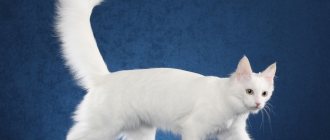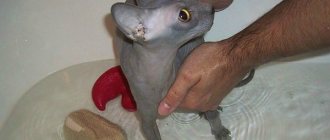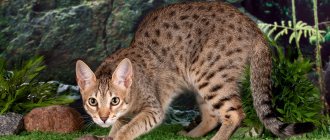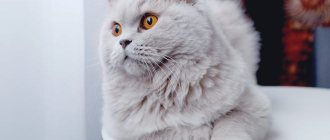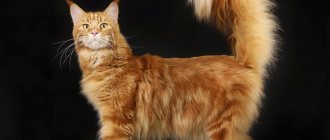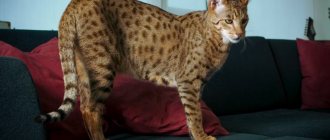Korat. One of the oldest cat breeds in Siam, it has long been endemic to its country and was considered a gift that will bring happiness and good luck. Kittens of the silver breed were never bought; they were usually presented as a gift to an important person, newlyweds, and as a wish for all the best on a holiday.
The blue-gray cat breed came to Europe and then to America thanks to the great wars. Since 1965, the breed began the path of obtaining an international standard and admission to all exhibitions and titles, which ended in 1982 with registration with the International Federation.
Korat
Now the breed is alive precisely thanks to its distribution in the USA, because you can easily buy a Korat kitten only in this country.
As for the appearance of the breed, there are a number of features:
- The cat is small, an adult does not exceed 5 kilograms, although most often these are cats 3-3.5 kilograms. Females are always smaller and more graceful than males.
- The cat's muzzle is wedge-shaped and, from the front, looks like a heart.
- The breed's fur has no undercoat, is short, lies close to the body and is very delicate to the touch.
- The most valuable shades of the iris are green, although the shade may change until the cat reaches 4 years of age.
- The main color is gray, but the more silver in the coat, the more valuable the kitten. The ideal show animal's coat color should be solid ticked silver blue.
- All the exterior features of the breed are fully formed by the age of 4.
Chartreuse (Carthusian cat)
Legend has it that the breed arrived in Persia from France along with preachers, and the countries of secondary distribution (Syria, Turkey, Iran) simply fell in love with the breed of cats with a stuffed gray coat and round cheeks for their talent to catch rodents in countless numbers. The breed received a modern standard in 1934, at which time the family tree of the breed was revealed. It is believed that the ancestors of the gray cat breed were the Pallas' cat and the Egyptian Mau, which later came to Siberia and formed the breed of Siberian cats, and later, through medieval selection, the stuffed, fur-bearing gray Chantreuse was bred. Gray cats were considered the only “non-messengers” of the devil and they were bred as fur-bearing edible rat catchers - not a cat, but a “universal soldier” for all occasions.
INTERESTING: the breed is often confused with the British Shorthair, although historically and legally these are two different breeds. You can distinguish a true Chartreuse by the evolution of the color of the iris - kittens have blue eyes, by adolescence they turn gray and in adulthood either a dark orange or a bright yellow tint appears.
The blue color in the color is uniform, deep, and goes very beautifully with the colors of the iris: dark orange or bright yellow. Gray is the only acceptable color, even the pads on the paws and nose are gray-blue, shades are not allowed.
The character of the breed is truly oriental - the cat is wary of strangers, and loves everyone in the family, but is not greedy for tenderness. This is a real cat, which is more on its own than the rest of the family.
Basic signs
For many centuries, information regarding smoky representatives of the cat breed has been collected, detailed and summarized. Due to this, the omen of a gray cat in the house can be interpreted in different ways.
- An ash-colored cat crossed the road - it’s your day. Luck and success will accompany you in all your endeavors. If you need the support of others, you can rest assured that they will give you a helping hand. “The gray cat is a lucky turn.”
- Picking up an iconic furry creature means getting a long-awaited promotion. Your work will be appreciated by management and will contribute to further career growth.
- Petting a gray pet helps fill the home with positive energy. Weasel enhances protection against evil spirits and evil intent.
- If you move with your smoky pet, you can count on quick adaptation, good neighbors and a cozy atmosphere in the new home. Your productivity will increase and your financial situation will improve accordingly.
- Watching a smoky cat settle down on the window of someone else’s house is a sign of receiving unpleasant news. You will have to change your lifestyle for the worse. Even the help of relatives will not be able to prevent unfavorable changes.
- Seeing a gray cat in a dream is a sign of danger. Fluffy warns of impending misfortune. Be careful when dealing with important issues.
- Kicking out a pet means loss of financial well-being for an indefinite period of time.
Russian blue cat
The long-lived, compact and very quiet Russian Blue cat breed originated in the Arkhangelsk province of Tsarist Russia and is still very popular throughout the world. The coat of the Russian Blue is short, but very dense and has a beautiful gray-blue color without any spots or marks. Large green irises add bonuses to the uniform plush coat.
The basis of exhibition competition for the breed is the quality and structure of the coat. It is this that serves as the main criterion for admission to exhibitions, and only then experts look at the general exterior of the animal.
Many owners note the independent character of the Russian Blue cat breed. Yes, the pet is affectionate, but if she doesn’t want contact, then you won’t be able to pet the cat. He loves to choose his owner and, as a result, the rest of the household may not wait at all for the indulgence of this graceful gray cat.
Who should get a gray cat?
Signs and beliefs about a gray cat in the house are interpreted in a positive way.
- If you are a successful entrepreneur or are the director of a large enterprise, a gray cat will contribute to your prudence when concluding deals, signing important contracts, and planning financial movements.
- For people who put their lives in danger while on duty, an ash-colored pet will help strengthen the protective aura and create a barrier against envy, anger and curses coming from bad people towards you.
- For unmarried young ladies, a gray cat predicts the appearance of an influential groom with whom they will find feminine happiness.
- For a pregnant woman, a silver-colored pet will help her to more easily endure all the difficulties of bearing a baby and will reduce the likelihood of complications during childbirth.
Nibelung
The beautiful name of the breed is fully justified by its appearance. The semi-longhaired cat captivates with its manners and grace.
The gray cat breed began its existence and career in worldwide cat fanciers in the 1980s, when the first mixed litters were obtained between a Russian Blue cat and a Black Shorthair cat. Crossbreeding gave impetus to recessive genes and by 1987 Cora Cobb had achieved a standard for a new breed, which, by the way, differed from the Russian Blue only in long hair.
The name of the breed was also given by Cora Cobb, who can safely be called the mother of all Nibelungs. The literal translation of the name is “child of the mists,” and this is very accurate, since the edges of the hairs of gray wool create a kind of haze around the animal in the light.
INTERESTING: Nibelungs inherited a quiet voice from their “grandmother” Russian Blue breed. It is almost impossible to hear the breed meow; the cat will convey all its demands to the owner through sign language and plastic movements, and only as a last resort will it “say” something.
The obligatory color of the breed is gray; tipping is allowed, but not encouraged. The irises of the eyes should be any shade of green. In males, a small mane is allowed; in females, its volume should be minimal. The fur coat is soft to the touch, the guard hair is longer on the pants and back. In summer the coat becomes shorter than in winter.
British shorthair cat
When a British Shorthair cat climbs onto your lap, you immediately feel the weight, the warmth, and the incredibly stuffed plush cat dough that you want to knead and squeeze. Yes, the breed has many shades, for some of them there is a real war among breeders, but the classic color of the breed is uniform gray, without stripes or stains.
The ancestors of the breed were Roman cats, rat catchers from ships, which the warriors of Rome brought with them to the territory of the modern Kingdom. But medieval views on the cat community did their job and until the 19th century no one thought about at least some kind of breeding, nevertheless, the beginnings of the breed were already there and a sufficient population of plush cats with abundant undercoat and a purely English, imperturbable character had formed.
The development of the breed, like many other English breeds, was influenced by the very first professional cat show in 1871. The next morning, the cats woke up not just as functional barn animals, but as interior decorations, popular pets and family friends.
Now the British breed has already split into two branches, gained popularity around the world and has acquired many shades of coat, but the historical color of the breed, gray, is still popular and is often presented at exhibitions.
Scottish fold cat
The large gray cat breed, originally from Great Britain, is a young breed, but its worldwide fame and popularity can no longer be denied.
The breed was formed in the 1960s and inherited from the British breed a thick coat and a phlegmatic character. The only serious difference is, perhaps, in the shape of the ears; otherwise the breeds are very similar.
The Scottish Fold is friendly and trouble-free. The owner needs to go to work - let him go, the owner is at home all day - that’s also normal. Of course, a cat loves its family, but it is so self-sufficient that the constant presence of a person will not make it happier; it is enough to pay attention to the cat in the evenings and a little in the morning so that the animal does not go wild in conditions of complete loneliness.
INTERESTING: the breed loves to get into a meerkat pose in moments of increased interest. The breed also does not like heights, which is very important if you have a rich interior and many shelves with souvenirs and interior decorations - all this will remain untouched, because this breed only needs to climb onto a soft sofa and is not at all interested in jumping on curtains and cabinets.
The breed's coat can be any color, but gray is the classic color that comes from the British Shorthair breed.
Personality of cats with yellow eyes
In the common opinion, there is a relationship between the disposition and color of a cat's eyes. Yellow-eyed beauties are considered calmer and more homely than green-eyed beauties, who have a rather difficult character.
However, in practice these are just stereotypes that have nothing to do with reality. The temperament of the animal depends on the breed and individual conditions of detention.
Interesting! Yellow-eyed cats see better in the dark than blue-eyed cats. The reason lies in the structural features of the retina, which in those with yellow pupils contains a luminescent pigment.
Yellow-eyed cats can belong to a variety of breeds. For some, this pupil color is mandatory according to the standard, for others it is only one of the options. The main thing to remember is that beautiful appearance when choosing a pet is not the main indicator. It is important that the animal and its owner are close in character.
Persian cat
The Persian breed is a pet that will delight your guests, but require daily care from you, just like a small child. The most common colors are smoky gray and all shades of peach.
The main problem of the breed is not even the upturned muzzle, which the owner has to wash every morning and evening, but the fluffy coat with significant undercoat and thin airy long main hair, which tends to matt into a dense tangle.
The breed has a very complex character. These cats were not bred to be outdoor mousers, they were originally domestic ornamental cats. Likewise, the modern Persian is sometimes ready to play with wind-up mice, but in general he is a calm cat, who will lie on a soft pillow next to him with great joy, rather than ask to sit on his lap or start chasing balls around the apartment.
The breed is also very attached to its owner and literally looks into the mouth, and if the cat is offended by something, then this becomes a big problem - pranks to spite the offender will turn life into a small war on the territory of a particular house. It is precisely because of this difficult character that the Persian cat breed is recommended for calm families with teenage children, because if the baby offends the cat, the whole family will take the rap.
American Ringtail
A distinctive feature of American ringtails is their curled tail, which is not considered a deformity. The breed was officially recognized only in 2004 in America. She is very rare. It can only be found in the United States.
Important! The cost of a ringtail is more than $1000.
Breed Features
American Ringtail
Table 8. Distinctive features of the American Ringtail
| Cat body part | Breed Features |
| Torso | Athletic build. The body is muscular and flexible. Length average |
| Head | Modified wedge shape. The muzzle has a slight curve as it meets the cheek. The chin is strong |
| Ears | Slightly diverge to the side and lean forward |
| Eyes | Widely spaced. They have the shape of an almond. The inner corners are lower than the upper ones. Any eye color |
| Nose | Small. Black, gray or pink |
| Limbs | Powerful. Paws are oval shaped. The hind limbs are larger than the forelimbs |
| Tail | Bent. Has a curl. Fully mobile |
| Wool | Soft. It is characterized by elasticity. The structure is plush. There is a small undercoat. The fur coat has a clear pattern. Medallions possible. The haze is colored cream, gray, black or red |
Character
Ringtails are friendly pets. They are very affectionate and get along freely with other animals in the house. They are good friends with children. Of all family members, they prefer to single out the most beloved one; they also treat everyone else well, but not with such reverence. Very talkative. They love to play and run around the apartment. Curious. Not aggressive. They love bathing procedures and can carry objects in their mouths .
Care and health
Ringtails should be brushed more often. Otherwise, all care procedures are standard. The breed is characterized by good health. There are no genetic diseases noted. Life expectancy is 14-18 years.
Egyptian Mau
The breed can be called the mother of all cats - wild and domestic, because the cats of Africa spread across the earth along with humans, wild and domesticated, forming many indigenous breeds with incredible evolutionary and mutational characteristics. Of course, the ancient Egyptian Mau was a little different than the modern one, but it makes no sense to argue that the breed has an ancient history, because images of thin, stately cats are on all Egyptian frescoes, and there are mentions in many ancient papyri. Even the cult of the goddess Bast is evidence of ancient origin.
The modern Egyptian Mau received the TICA standard in 1988, but has not yet reached universal distribution. The point is not in problematic content or bad character, but in the fact that, like many aboriginal breeds, the Mau for a long time had conventional outlines of the exterior and was deprived of a controlled gene pool. In this regard, there are now very few nurseries and breeders who are able to adhere to targeted selection. American breeders have achieved success, but they do not want to involve less successful European felinologists in replenishing the population.
However, the Egyptian gray cat breed standard specifies three colors that breeders should strive for when culling litters:
- Smoky - from black to dark gray, the points are always visible in contrast due to the presence of a silvery undercoat. Hair ticking is minimal.
- Silver – can vary from light to gray. The points correspond to the shade and range from black to dark gray. The neck and chin may have white fuzz.
- Bronze – creamy milky colors with dark brown points. It is found relatively less frequently than the first two, but is not inferior in beauty.
Breed standards for gray color
Gray color belongs to the group of solid (solid, self). The European Felinological Federation introduced a system of color designation indices. The personal blue color code is indicated by the letter “a”.
Table: requirements for blue color
| Options | Standard requirements |
| Color |
|
| Paw pad color | To match the main coat color (any shades of gray) |
| Nose speculum color | |
| Eye color |
|
Reasons for disqualification:
- colored hairs in color;
- uneven color along the entire length of the hair;
- cloudy or faded eye color;
- blurry rims around the iris;
- Various spots on paw pads and tip of nose.
Experts recommend distinguishing between smoky individuals and gray pets. Smoky cats were identified as a separate group in 1983. The official name of the color is smoke. At first glance, smoky cats are absolutely similar to monochrome ones, but in the dynamics it becomes noticeable that the animal’s fur has a white undercoat. The sharper the contrast between the main coat and the undercoat, the better the quality of the smoky color.
Video: gray cats - smoky luck
Ocicat
The name of the breed is a reference to ocelots, but in fact, a young breed of blue-gray cats was developed from Abyssinian, Siamese and American Shorthair cats. The experiment was successful and the world saw a beautiful cat with a color like a wild ocelot, but gentle habits and a great love for her family.
A big plus of the breed is its great attachment to home and habits similar to those of a dog. If you take up raising and training a kitten, then walking on a harness and playing with a ball can become your constant entertainment with your pet.
The breed's disadvantages are associated with recessive genetic diseases that have accumulated as a result of selection. Most of them are inherited from Siamese blood and are complicated by the fact that the cat may not get sick for some time, but under a number of circumstances, the hereditary disease can “wake up” and the cat will die due to the transience of the disease.
The breed is not picky when it comes to grooming, but its teeth require especially close care – the enamel is prone to destruction and it’s not worth leaving plaque on the furry’s teeth.
The most common colors: brown and chocolate shades, lilac, blue and all pairs with blue from chocolate-silver to blue-silver. The hair is always ticked, and the markings on the body vary in saturation depending on where they are located.
Gray kitten in the house: adaptation period
Have you decided to get a purebred gray kitten? Then you should learn about how to prepare your home for his arrival. After all, a new family for any animal is very stressful. And its manifestations must be minimized. After purchasing, you need to ask the breeders for something with the animal’s native scent. It must be placed in the bed where the kitten will sleep. Familiar vibes will calm the little creature, he will be less afraid of the new environment.
All household chemicals, poisonous flowers, dangerous objects, wires, cosmetics, as well as valuables should be placed higher up. Otherwise, if the inquisitive gray kitten gets to them first, disaster may occur.
For a gray cat you need to prepare various accessories: scratching post, tray, bowls, toys. The sleeping place for the gray breed is chosen in a quiet and closed corner. Because many representatives of the gray color have a strong tendency towards solitude.
British blue
In families with children, these cats occupy a “middle” position in the hierarchy. They will not play excitingly with children for hours. And in case of any attempts to encroach on their borders, they retreat to a place inaccessible to others.
Representatives of gray cat breeds have a special weakness for their owners. They can form a strong empathic bond with their owners. And this union will last for many years. But if a gray cat does not accept someone, then, unfortunately, this is forever. Therefore, raising a gray kitten must be approached consciously. Punishments should be alternated evenly with rewards. And in some cases you will have to give in to your beloved pet.
Breeds of gray cats experience some difficulties when living in the same territory with other animals. These creatures get along well with other cats. But it’s difficult to tolerate dogs in your home.
Adult gray cats become attached to their owners with all their souls and rarely agree to change their owner. Therefore, they should be taken into the family as very young kittens.
Persian cat
Caring for breeds with gray coats
Owners of gray breeds should take care of their pets' diet in such a way that it contains a minimum amount of iodine. From an overabundance of this substance, gray wool begins to cast brown. And this circumstance may serve as a basis for culling the cat. Such an animal will not be allowed to participate in competitions.
The fur of such cats also fades in the sun. The color can also deteriorate due to high humidity in the room. Also, each breed has its own care requirements.
The Russian Blue cat does not require special care. It only needs to be bathed once every six months, but it should be combed more often. But here, once a week is enough. Gray cat hairs do not tolerate rough combs; it is better to choose a soft brush for combing.
Russian blue cat
The gray-haired Angora cat needs a bath every two to three months. Their coat is very long and should be brushed a couple of times a week to prevent clumps. Many representatives of this breed love water, so if you start getting used to water procedures from childhood, then there will be no problems in the future.
Gray Persians differ from other breeds in their more delicate health. You can bathe them every three weeks, but you will also have to carefully monitor the drying of the wool, otherwise the color will deteriorate.
British Blues are low maintenance. Frequent brushing is encouraged when keeping them. The “British” ones are washed twice a year. Otherwise, they are cared for in the same way as other cats.
The Carthusian or Charteuse cat has a thick and water-repellent undercoat. Because of it, the process of drying an animal turns into a real adventure. After bathing, Charteuses should be kept in a warm room for several days. And only then will their hairs dry completely.
The Korat is a breed especially revered in Thailand. These cats should not be bathed at all. If you still have to do this, you will need special shampoos and soft towels. Washing can cause bald spots on an elegant coat. And the wool itself will lose its protective properties.
Nibelung cats know how to keep their fur clean. If you bathe them frequently, the color of their coat will certainly deteriorate. Before bathing, the Nibelungen's ears are stuffed with cotton wool. The process itself is carried out only when obvious contamination occurs. The beauties are combed once a week.
All gray cats are naturally in good health. They rarely get sick and tolerate climate change and various changes in diet well. Their ears and eyes do not become overgrown with dirt and secretions. And gray wool, most often, is endowed with the ability to self-clean.


